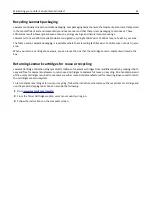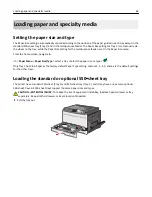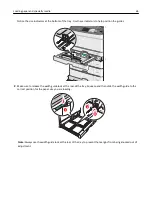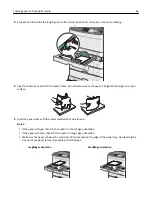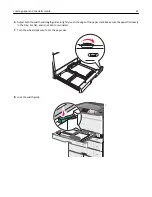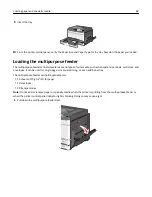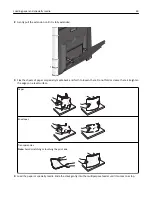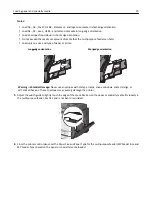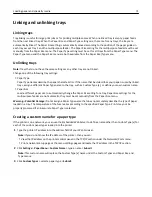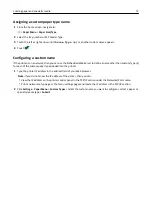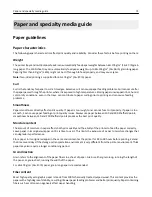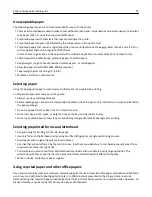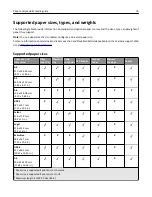
Unacceptable paper
The following paper types are not recommended for use with the printer:
•
Chemically treated papers used to make copies without carbon paper, also known as carbonless papers, carbonless
copy paper (CCP), or no carbon required (NCR) paper
•
Preprinted papers with chemicals that may contaminate the printer
•
Preprinted papers that can be affected by the temperature in the printer fuser
•
Preprinted papers that require a registration (the precise print location on the page) greater than ±2.3 mm (±0.9 in.),
such as optical character recognition (OCR) forms
In some cases, registration can be adjusted with a software application to successfully print on these forms.
•
Coated papers (erasable bond), synthetic papers, thermal papers
•
Rough
‑
edged, rough or heavily textured surface papers, or curled papers
•
Recycled papers that fail EN12281:2002 (European)
•
Paper weighing less than 60 g/m
2
(16 lb)
•
Multiple
‑
part forms or documents
Selecting paper
Using the appropriate paper prevents jams and helps ensure trouble
‑
free printing.
To help avoid paper jams and poor print quality:
•
Always
use new, undamaged paper.
•
Before loading paper, know the recommended printable side of the paper. This information is usually indicated on
the paper package.
•
Do not
use paper that has been cut or trimmed by hand.
•
Do not
mix paper sizes, types, or weights in the same tray; mixing results in jams.
•
Do not
use coated papers unless they are specifically designed for electrophotographic printing.
Selecting preprinted forms and letterhead
•
Use grain long for 60–90
‑
g/m
2
(16–24
‑
lb) paper.
•
Use only forms and letterhead printed using an offset lithographic or engraved printing process.
•
Avoid paper with rough or heavily textured surfaces.
•
Use inks that are not affected by the resin in toner. Inks that are oxidation
‑
set or oil
‑
based generally meet these
requirements; latex inks might not.
•
Print samples on preprinted forms and letterheads considered for use before buying large quantities. This
determines whether or not the ink in the preprinted form or letterhead will affect print quality.
•
When in doubt, contact your paper supplier.
Using recycled paper and other office papers
As an environmentally conscious company, Lexmark supports the use of recycled office paper produced specifically for
use in laser and LED (electrophotographic) printers. In 1998, Lexmark presented to the US government a study
demonstrating that recycled paper produced by major mills in the US fed as well as non-recycled paper. However, no
blanket statement can be made that
all
recycled paper will feed well.
Paper and specialty media guide
74




